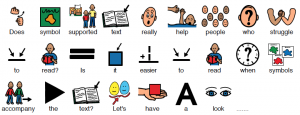The introduction above has been written in symbols. Did you find it easy to read? Did you struggle to read it? Is the version below easier?
When I first started working as a speech language pathologist, nearly 25 years ago, we were all using symbol supported text to help our struggling readers and writers. We used it with the intention of "simplifying" text so that the people we were working with were able to "read" the text. However, this approach fell out of favour for the simple reason that it didn't practically help many of the people we were working with - and also because we realised that the students we were using it with seemed to take longer to learn to read traditional text when we used symbols paired with writing. However, I have noticed that recently some people have started using this approach again and I'm writing this blog post to reflect my concern that we haven't learned from our own history.
For symbol supported text to be successful it requires a really good knowledge of symbols. Most of you will not have been able to read the first part of this blog with meaning - it only made sense to you when I added the text to the symbols. As a Speech Pathologist who has been working in the area of AAC for most of my working life, I feel I have a good knowledge of symbols - but every time someone takes a piece of symbol supported text and removes the text I struggle to read it, just as you did.
For these reasons (and for others) using symbols to support a student's understanding of text is an approach that doesn't always achieve its intended outcome. It is also an approach that may have unintended consequences as it may also interfere with literacy development.
Erickson, Hatch & Clendon (2010) cover the research around this topic and I strongly recommend you access this article as further reading. In summary, though, there is a lot of research out there warning us to exercise caution in using this approach with developing readers and writers.
As you can see in the symbol supported text above, sometimes a symbol can actually increase confusion for a student when it is used to represent a word that has multiple meanings. A symbol can direct a reader to incorrectly interpret a word using one of its alternative meanings, thereby preventing the reader from gaining comprehension of the piece of text.
In addition, some words don't have an obvious representation. A word like "the" is represented by a graphic symbol that is possibly even more abstract than the word. At least the student gets to see "the" repeatedly in lots of different environments, which gives them a greater chance to not only learn the word but also to learn how it is used. Lots of other people also know what "the" means. The symbol representing "the" will only be seen in limited places, is understood by a small number of people, and is probably just as difficult to learn as the word "the" - all of which makes it harder for the student to learn a representation that isn't universally accepted.
There is also a lot of research, going back to the 1960s, showing that a student will learn a word more easily when he or she is taught the word on its own. Teaching the word paired with a symbol does not help student to learn the word - in fact pairing the word with a symbol delays the student learning the text. This research has been conducted with different groups, including people with intellectual disability.
And please don't think that I don't like symbols. Symbols are enormously important in AAC and I use them daily. They are have a pivotal role in communication development and success and also in behaviour supports, such as visual schedules. But I don't ever use them in literacy teaching or compensation for all the reasons listed above and I encourage you to be careful about using symbol supported text as well.
And for lots more information, including specific references, please read:
Erickson, K.A., Hatch, P. & Clendon, S. (2010). Literacy, Assistive Technology, and Students with Significant Disabilities. Focus on Exceptional Children, 42(5), 1 - 16.




Carol Leynse Harpold
Merell Liddle
Jane
steven aylward
Jane
Anna Newstead
Jane
Pingback: PrAACtical AAC | Supports for language learning
Raf
Jane
Pingback: Symbol Supported Text: Does it really help? | All Things Linguistic
Pingback: Using Adapted Books with AAC Learners: 3 Important Questions to Ask : PrAACtical AAC
Angelica
jane
Kerri